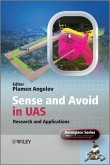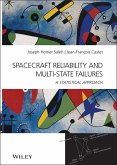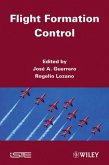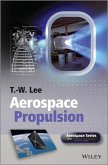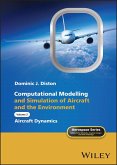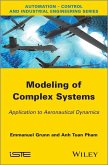Sense and Avoid in UAS (eBook, PDF)
Research and Applications
Redaktion: Angelov, Plamen


Alle Infos zum eBook verschenken

Sense and Avoid in UAS (eBook, PDF)
Research and Applications
Redaktion: Angelov, Plamen
- Format: PDF
- Merkliste
- Auf die Merkliste
- Bewerten Bewerten
- Teilen
- Produkt teilen
- Produkterinnerung
- Produkterinnerung

Hier können Sie sich einloggen

Bitte loggen Sie sich zunächst in Ihr Kundenkonto ein oder registrieren Sie sich bei bücher.de, um das eBook-Abo tolino select nutzen zu können.
There is increasing interest in the potential of UAV (Unmanned Aerial Vehicle) and MAV (Micro Air Vehicle) technology and their wide ranging applications including defence missions, reconnaissance and surveillance, border patrol, disaster zone assessment and atmospheric research. High investment levels from the military sector globally is driving research and development and increasing the viability of autonomous platforms as replacements for the remotely piloted vehicles more commonly in use. UAV/UAS pose a number of new challenges, with the autonomy and in particular collision avoidance,…mehr
- Geräte: PC
- mit Kopierschutz
- eBook Hilfe
- Größe: 37.37MB
![Sense and Avoid in UAS (eBook, ePUB) Sense and Avoid in UAS (eBook, ePUB)]() Sense and Avoid in UAS (eBook, ePUB)97,99 €
Sense and Avoid in UAS (eBook, ePUB)97,99 €![Spacecraft Reliability and Multi-State Failures (eBook, PDF) Spacecraft Reliability and Multi-State Failures (eBook, PDF)]() Joseph Homer SalehSpacecraft Reliability and Multi-State Failures (eBook, PDF)116,99 €
Joseph Homer SalehSpacecraft Reliability and Multi-State Failures (eBook, PDF)116,99 €![Introduction to UAV Systems (eBook, PDF) Introduction to UAV Systems (eBook, PDF)]() Paul G. FahlstromIntroduction to UAV Systems (eBook, PDF)116,99 €
Paul G. FahlstromIntroduction to UAV Systems (eBook, PDF)116,99 €![Flight Formation Control (eBook, PDF) Flight Formation Control (eBook, PDF)]() Flight Formation Control (eBook, PDF)144,99 €
Flight Formation Control (eBook, PDF)144,99 €![Aerospace Propulsion (eBook, PDF) Aerospace Propulsion (eBook, PDF)]() T. W. LeeAerospace Propulsion (eBook, PDF)78,99 €
T. W. LeeAerospace Propulsion (eBook, PDF)78,99 €![Computational Modelling and Simulation of Aircraft and the Environment, Volume 2 (eBook, PDF) Computational Modelling and Simulation of Aircraft and the Environment, Volume 2 (eBook, PDF)]() Dominic J. DistonComputational Modelling and Simulation of Aircraft and the Environment, Volume 2 (eBook, PDF)66,99 €
Dominic J. DistonComputational Modelling and Simulation of Aircraft and the Environment, Volume 2 (eBook, PDF)66,99 €![Modeling of Complex Systems (eBook, PDF) Modeling of Complex Systems (eBook, PDF)]() Emanuel GrunnModeling of Complex Systems (eBook, PDF)139,99 €
Emanuel GrunnModeling of Complex Systems (eBook, PDF)139,99 €-
-
-
Dieser Download kann aus rechtlichen Gründen nur mit Rechnungsadresse in A, B, BG, CY, CZ, D, DK, EW, E, FIN, F, GR, HR, H, IRL, I, LT, L, LR, M, NL, PL, P, R, S, SLO, SK ausgeliefert werden.
- Produktdetails
- Verlag: Wiley
- Seitenzahl: 384
- Erscheinungstermin: 6. März 2012
- Englisch
- ISBN-13: 9781119963950
- Artikelnr.: 37355669
- Verlag: Wiley
- Seitenzahl: 384
- Erscheinungstermin: 6. März 2012
- Englisch
- ISBN-13: 9781119963950
- Artikelnr.: 37355669
- Herstellerkennzeichnung Die Herstellerinformationen sind derzeit nicht verfügbar.
pán Kop
iva, David ilák and Michal P
choüek 6.1 Introduction 145 6.2 Conflict Detection and Resolution Principles 146 6.2.1 Sensing 146 6.2.2 Trajectory Prediction 147 6.2.3 Conflict Detection 148 6.2.4 Conflict Resolution 149 6.2.5 Evasion Maneuvers 150 6.3 Categorization of Conflict Detection and Resolution Approaches 150 6.3.1 Taxonomy 150 6.3.2 Rule-Based Methods 151 6.3.3 Game Theory Methods 152 6.3.4 Field Methods 153 6.3.5 Geometric Methods 154 6.3.6 Numerical Optimization Approaches 156 6.3.7 Combined Methods 158 6.3.8 Multi-agent Methods 160 6.3.9 Other Methods 163 Acknowledgments 166 References 166 7 UAS Conflict Detection and Resolution Using Differential Geometry Concepts 175 Hyo-Sang Shin, Antonios Tsourdos and Brian White 7.1 Introduction 175 7.2 Differential Geometry Kinematics 177 7.3 Conflict Detection 178 7.3.1 Collision Kinematics 178 7.3.2 Collision Detection 180 7.4 Conflict Resolution: Approach I 182 7.4.1 Collision Kinematics 183 7.4.2 Resolution Guidance 186 7.4.3 Analysis and Extension 188 7.5 Conflict Resolution: Approach II 191 7.5.1 Resolution Kinematics and Analysis 192 7.5.2 Resolution Guidance 193 7.6 CD&R Simulation 195 7.6.1 Simulation Results: Approach I 195 7.6.2 Simulation Results: Approach II 199 7.7 Conclusions 200 References 203 8 Aircraft Separation Management Using Common Information Network SAA 205 Richard Baumeister and Graham Spence 8.1 Introduction 205 8.2 CIN Sense and Avoid Requirements 208 8.3 Automated Separation Management on a CIN 212 8.3.1 Elements of Automated Aircraft Separation 212 8.3.2 Grid-Based Separation Automation 214 8.3.3 Genetic-Based Separation Automation 214 8.3.4 Emerging Systems-Based Separation Automation 216 8.4 Smart Skies Implementation 217 8.4.1 Smart Skies Background 217 8.4.2 Flight Test Assets 217 8.4.3 Communication Architecture 219 8.4.4 Messaging System 221 8.4.5 Automated Separation Implementation 223 8.4.6 Smart Skies Implementation Summary 223 8.5 Example SAA on a CIN - Flight Test Results 224 8.6 Summary and Future Developments 229 Acknowledgments 231 References 231 Part IV SAA Applications 9 AgentFly: Scalable, High-Fidelity Framework for Simulation, Planning and Collision Avoidance of Multiple UAVs 235 David ilák, P
emysl Volf, t
pán Kop
iva and Michal P
choüek 9.1 Agent-Based Architecture 236 9.1.1 UAV Agents 237 9.1.2 Environment Simulation Agents 237 9.1.3 Visio Agents 238 9.2 Airplane Control Concept 238 9.3 Flight Trajectory Planner 241 9.4 Collision Avoidance 245 9.4.1 Multi-layer Collision Avoidance Architecture 246 9.4.2 Cooperative Collision Avoidance 247 9.4.3 Non-cooperative Collision Avoidance 250 9.5 Team Coordination 252 9.6 Scalable Simulation 256 9.7 Deployment to Fixed-Wing UAV 260 Acknowledgments 263 References 263 10 See and Avoid Using Onboard Computer Vision 265 John Lai, Jason J. Ford, Luis Mejias, Peter O'Shea and Rod Walker 10.1 Introduction 265 10.1.1 Background 265 10.1.2 Outline of the SAA Problem 265 10.2 State-of-the-Art 266 10.3 Visual-EO Airborne Collision Detection 268 10.3.1 Image Capture 268 10.3.2 Camera Model 269 10.4 Image Stabilization 269 10.4.1 Image Jitter 269 10.4.2 Jitter Compensation Techniques 270 10.5 Detection and Tracking 272 10.5.1 Two-Stage Detection Approach 272 10.5.2 Target Tracking 278 10.6 Target Dynamics and Avoidance Control 278 10.6.1 Estimation of Target Bearing 278 10.6.2 Bearing-Based Avoidance Control 279 10.7 Hardware Technology and Platform Integration 281 10.7.1 Target/Intruder Platforms 281 10.7.2 Camera Platforms 282 10.7.3 Sensor Pod 286 10.7.4 Real-Time Image Processing 288 10.8 Flight Testing 289 10.8.1 Test Phase Results 290 10.9 Future Work 290 10.10 Conclusions 291 Acknowledgements 291 References 291 11 The Use of Low-Cost Mobile Radar Systems for Small UAS Sense and Avoid 295 Michael Wilson 11.1 Introduction 295 11.2 The UAS Operating Environment 297 11.2.1 Why Use a UAS? 297 11.2.2 Airspace and Radio Carriage 297 11.2.3 See-and-Avoid 297 11.2.4 Midair Collisions 298 11.2.5 Summary 299 11.3 Sense and Avoid and Collision Avoidance 300 11.3.1 A Layered Approach to Avoiding Collisions 300 11.3.2 SAA Technologies 300 11.3.3 The UA Operating Volume 303 11.3.4 Situation Awareness 304 11.3.5 Summary 304 11.4 Case Study: The Smart Skies Project 305 11.4.1 Introduction 305 11.4.2 Smart Skies Architecture 305 11.4.3 The Mobile Aircraft Tracking System 307 11.4.4 The Airborne Systems Laboratory 310 11.4.5 The Flamingo UAS 311 11.4.6 Automated Dynamic Airspace Controller 311 11.4.7 Summary 312 11.5 Case Study: Flight Test Results 312 11.5.1 Radar Characterisation Experiments 312 11.5.2 Sense and Avoid Experiments 319 11.5.3 Automated Sense and Avoid 324 11.5.4 Dynamic Sense and Avoid Experiments 326 11.5.5 Tracking a Variety of Aircraft 326 11.5.6 Weather Monitoring 331 11.5.7 The Future 332 11.6 Conclusion 333 Acknowledgements 333 References 334 Epilogue 337 Index 339
pán Kop
iva, David ilák and Michal P
choüek 6.1 Introduction 145 6.2 Conflict Detection and Resolution Principles 146 6.2.1 Sensing 146 6.2.2 Trajectory Prediction 147 6.2.3 Conflict Detection 148 6.2.4 Conflict Resolution 149 6.2.5 Evasion Maneuvers 150 6.3 Categorization of Conflict Detection and Resolution Approaches 150 6.3.1 Taxonomy 150 6.3.2 Rule-Based Methods 151 6.3.3 Game Theory Methods 152 6.3.4 Field Methods 153 6.3.5 Geometric Methods 154 6.3.6 Numerical Optimization Approaches 156 6.3.7 Combined Methods 158 6.3.8 Multi-agent Methods 160 6.3.9 Other Methods 163 Acknowledgments 166 References 166 7 UAS Conflict Detection and Resolution Using Differential Geometry Concepts 175 Hyo-Sang Shin, Antonios Tsourdos and Brian White 7.1 Introduction 175 7.2 Differential Geometry Kinematics 177 7.3 Conflict Detection 178 7.3.1 Collision Kinematics 178 7.3.2 Collision Detection 180 7.4 Conflict Resolution: Approach I 182 7.4.1 Collision Kinematics 183 7.4.2 Resolution Guidance 186 7.4.3 Analysis and Extension 188 7.5 Conflict Resolution: Approach II 191 7.5.1 Resolution Kinematics and Analysis 192 7.5.2 Resolution Guidance 193 7.6 CD&R Simulation 195 7.6.1 Simulation Results: Approach I 195 7.6.2 Simulation Results: Approach II 199 7.7 Conclusions 200 References 203 8 Aircraft Separation Management Using Common Information Network SAA 205 Richard Baumeister and Graham Spence 8.1 Introduction 205 8.2 CIN Sense and Avoid Requirements 208 8.3 Automated Separation Management on a CIN 212 8.3.1 Elements of Automated Aircraft Separation 212 8.3.2 Grid-Based Separation Automation 214 8.3.3 Genetic-Based Separation Automation 214 8.3.4 Emerging Systems-Based Separation Automation 216 8.4 Smart Skies Implementation 217 8.4.1 Smart Skies Background 217 8.4.2 Flight Test Assets 217 8.4.3 Communication Architecture 219 8.4.4 Messaging System 221 8.4.5 Automated Separation Implementation 223 8.4.6 Smart Skies Implementation Summary 223 8.5 Example SAA on a CIN - Flight Test Results 224 8.6 Summary and Future Developments 229 Acknowledgments 231 References 231 Part IV SAA Applications 9 AgentFly: Scalable, High-Fidelity Framework for Simulation, Planning and Collision Avoidance of Multiple UAVs 235 David ilák, P
emysl Volf, t
pán Kop
iva and Michal P
choüek 9.1 Agent-Based Architecture 236 9.1.1 UAV Agents 237 9.1.2 Environment Simulation Agents 237 9.1.3 Visio Agents 238 9.2 Airplane Control Concept 238 9.3 Flight Trajectory Planner 241 9.4 Collision Avoidance 245 9.4.1 Multi-layer Collision Avoidance Architecture 246 9.4.2 Cooperative Collision Avoidance 247 9.4.3 Non-cooperative Collision Avoidance 250 9.5 Team Coordination 252 9.6 Scalable Simulation 256 9.7 Deployment to Fixed-Wing UAV 260 Acknowledgments 263 References 263 10 See and Avoid Using Onboard Computer Vision 265 John Lai, Jason J. Ford, Luis Mejias, Peter O'Shea and Rod Walker 10.1 Introduction 265 10.1.1 Background 265 10.1.2 Outline of the SAA Problem 265 10.2 State-of-the-Art 266 10.3 Visual-EO Airborne Collision Detection 268 10.3.1 Image Capture 268 10.3.2 Camera Model 269 10.4 Image Stabilization 269 10.4.1 Image Jitter 269 10.4.2 Jitter Compensation Techniques 270 10.5 Detection and Tracking 272 10.5.1 Two-Stage Detection Approach 272 10.5.2 Target Tracking 278 10.6 Target Dynamics and Avoidance Control 278 10.6.1 Estimation of Target Bearing 278 10.6.2 Bearing-Based Avoidance Control 279 10.7 Hardware Technology and Platform Integration 281 10.7.1 Target/Intruder Platforms 281 10.7.2 Camera Platforms 282 10.7.3 Sensor Pod 286 10.7.4 Real-Time Image Processing 288 10.8 Flight Testing 289 10.8.1 Test Phase Results 290 10.9 Future Work 290 10.10 Conclusions 291 Acknowledgements 291 References 291 11 The Use of Low-Cost Mobile Radar Systems for Small UAS Sense and Avoid 295 Michael Wilson 11.1 Introduction 295 11.2 The UAS Operating Environment 297 11.2.1 Why Use a UAS? 297 11.2.2 Airspace and Radio Carriage 297 11.2.3 See-and-Avoid 297 11.2.4 Midair Collisions 298 11.2.5 Summary 299 11.3 Sense and Avoid and Collision Avoidance 300 11.3.1 A Layered Approach to Avoiding Collisions 300 11.3.2 SAA Technologies 300 11.3.3 The UA Operating Volume 303 11.3.4 Situation Awareness 304 11.3.5 Summary 304 11.4 Case Study: The Smart Skies Project 305 11.4.1 Introduction 305 11.4.2 Smart Skies Architecture 305 11.4.3 The Mobile Aircraft Tracking System 307 11.4.4 The Airborne Systems Laboratory 310 11.4.5 The Flamingo UAS 311 11.4.6 Automated Dynamic Airspace Controller 311 11.4.7 Summary 312 11.5 Case Study: Flight Test Results 312 11.5.1 Radar Characterisation Experiments 312 11.5.2 Sense and Avoid Experiments 319 11.5.3 Automated Sense and Avoid 324 11.5.4 Dynamic Sense and Avoid Experiments 326 11.5.5 Tracking a Variety of Aircraft 326 11.5.6 Weather Monitoring 331 11.5.7 The Future 332 11.6 Conclusion 333 Acknowledgements 333 References 334 Epilogue 337 Index 339

